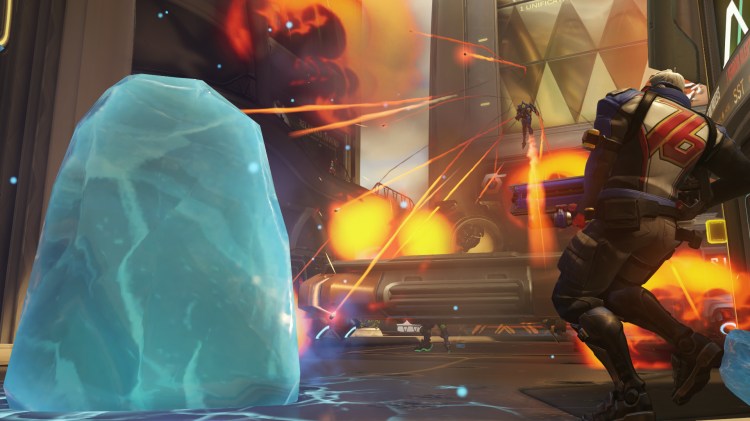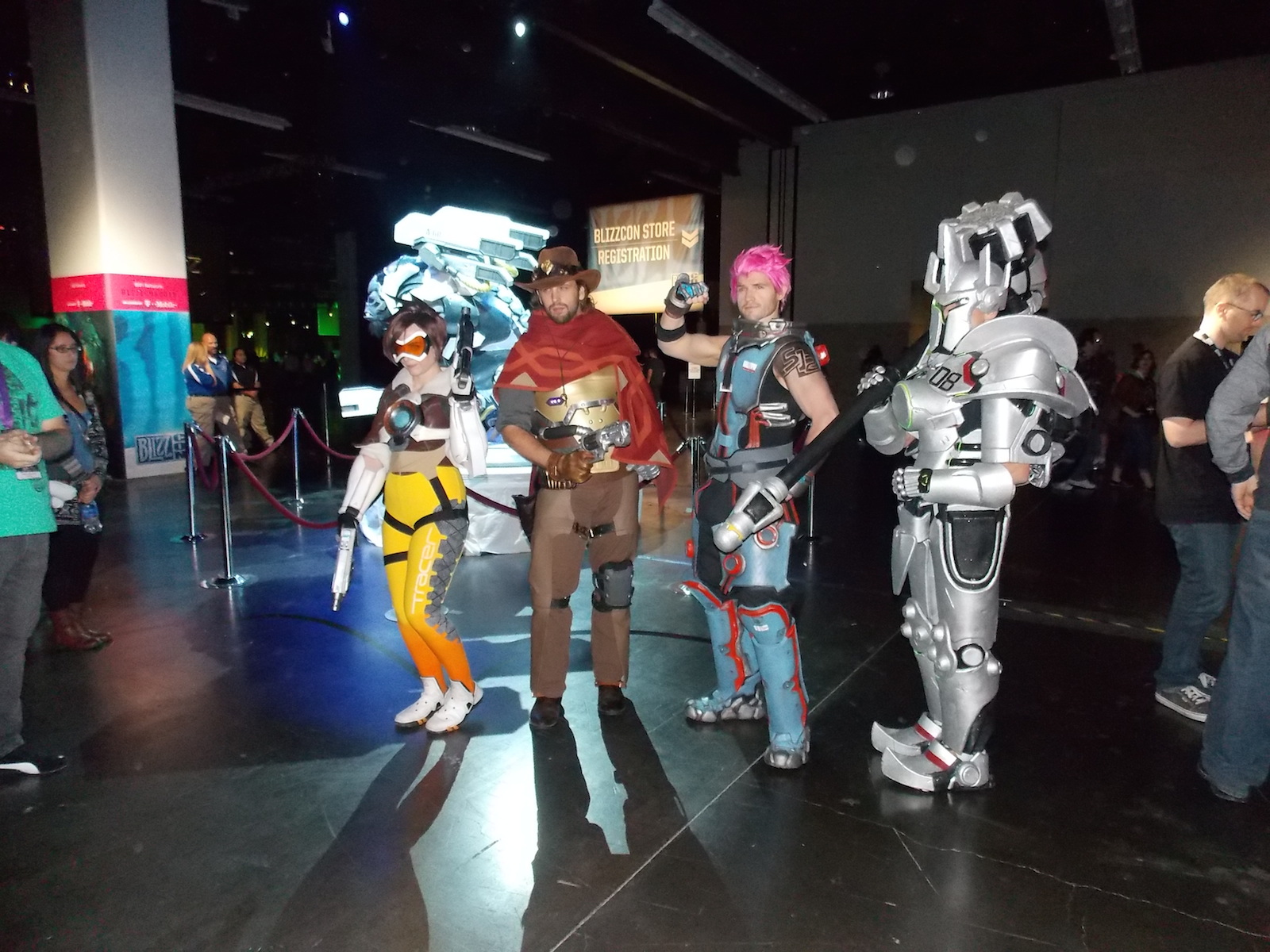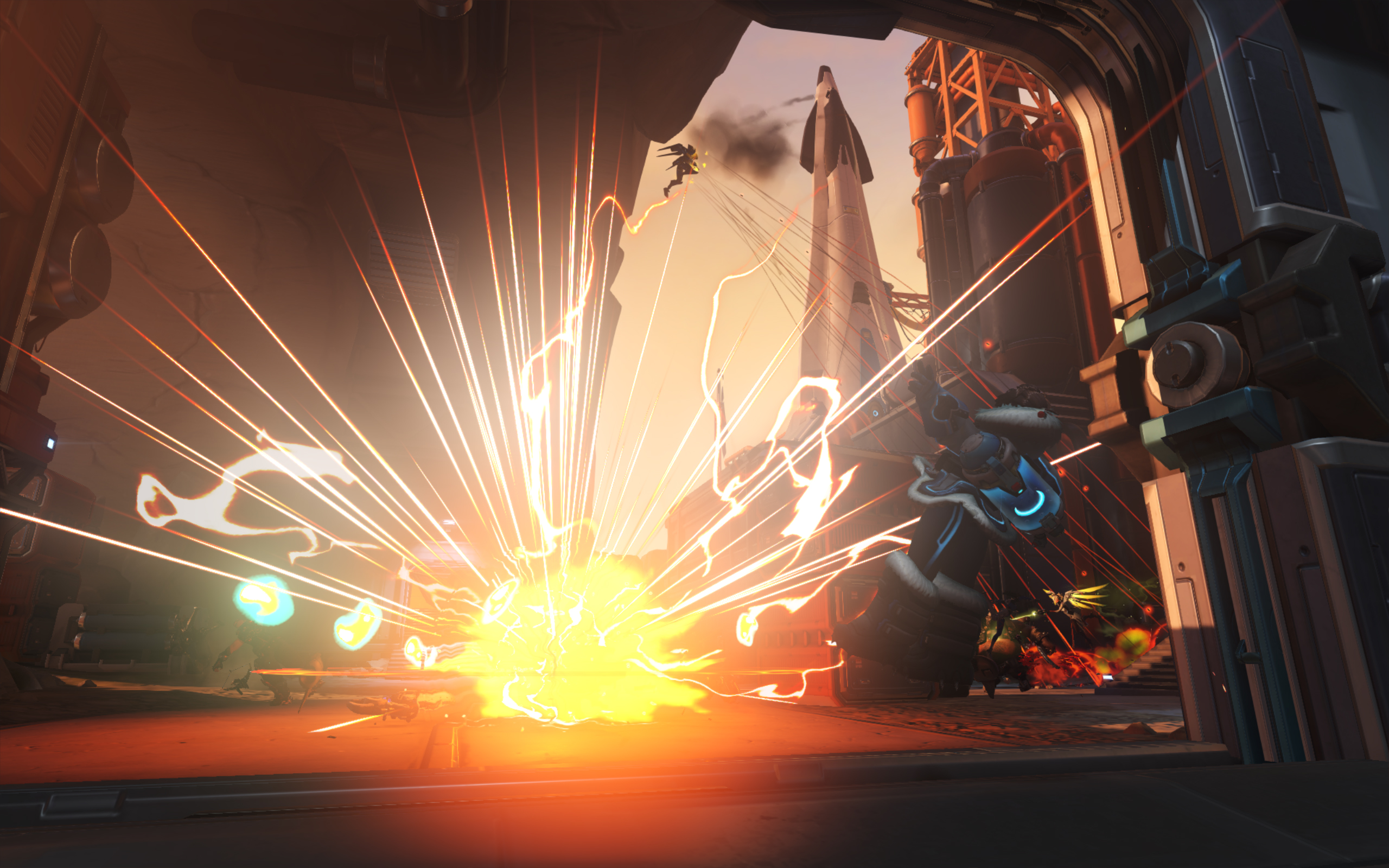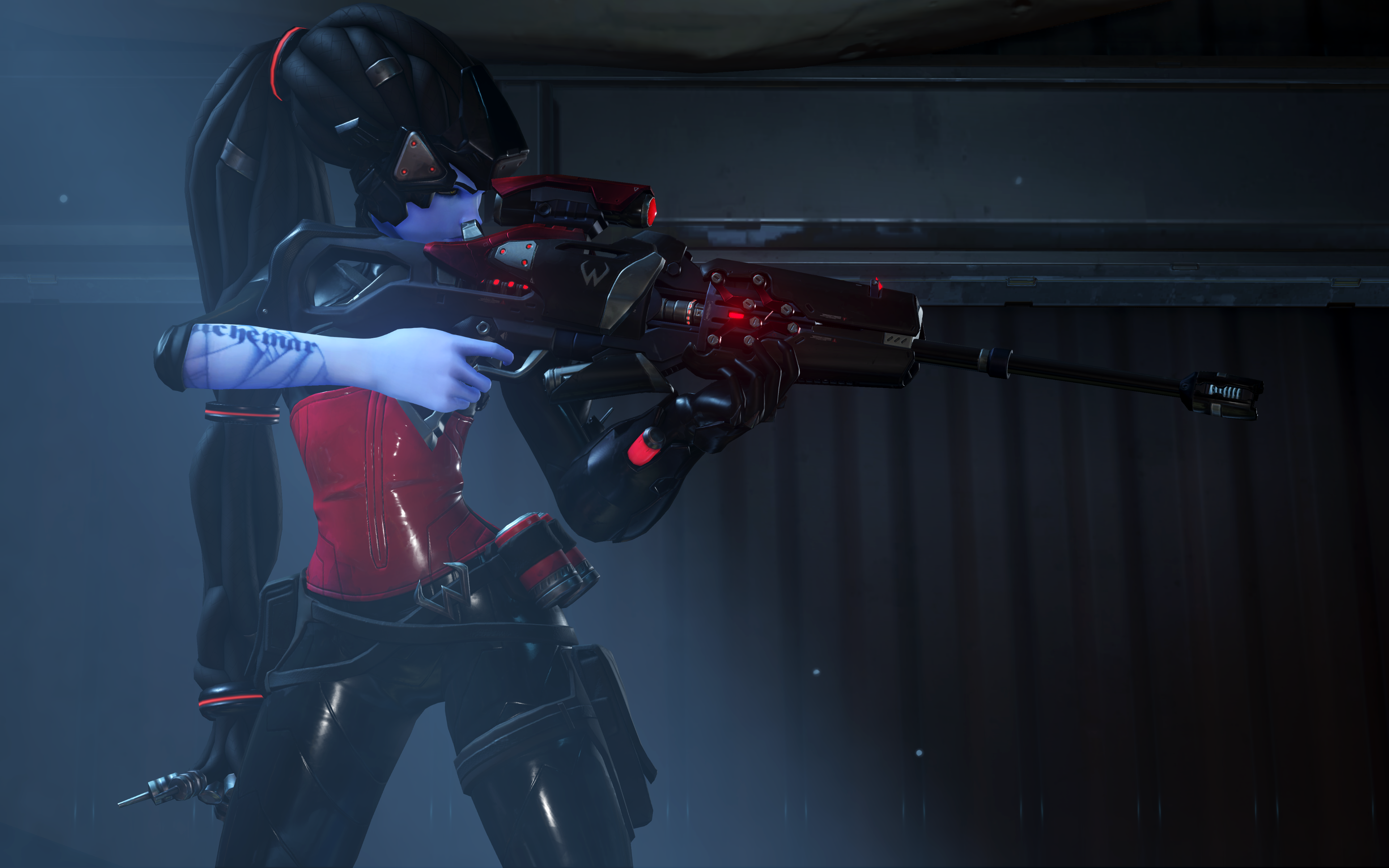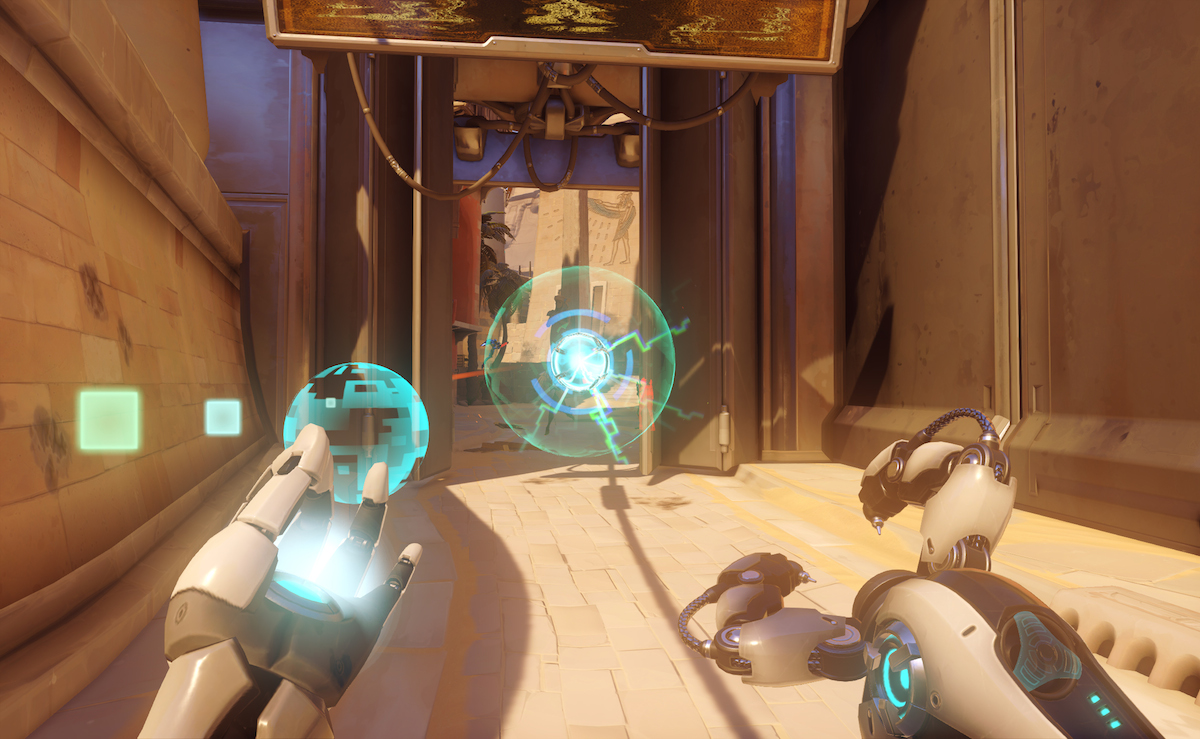The developers of Overwatch, Blizzard Entertainment’s team shooter launching this spring, have a lot riding on their shoulders.
The game is Blizzard’s first new game that’s not from an established franchise since World of Warcraft launched in 2004. It’s the company’s first new intellectual property in almost 18 years since StarCraft’s 1998 launch.
It’s the company’s first brand-new console game ever, and its previous forays into controller territory haven’t all ended well. Diablo III did well. But third-person stealth shooter Starcraft: Ghost was scrapped even after I, as a journalist, had played single- and multiplayer missions at Blizzard headquarters — which meant it was pretty darned far along.
And no, this doesn’t count:
So when we caught up with Overwatch assistant game director Aaron Keller and lead gameplay engineer Tim Ford recently, I asked them to tell us about the development process for Blizzard’s new game. No pressure, guys.
GamesBeat: So how did you arrive on Overwatch’s team-shooter model?
Aaron Keller: We started the project a little over two years ago. We knew we wanted to make a shooter, and we knew we wanted it to be an ability-based, hero-based shooter. It started to coalesce into something that had the razor-sharp focus that the game has right now, which is this competitive multiplayer game. That’s what we’re really excited about for Overwatch, is two teams coming together, exploring this big cast of heroes, and seeing who comes out the better team.
GamesBeat: But offering up all the heroes at once means you can’t release or sell them later.
Keller: It’s really important for us for people to be able to switch heroes midmatch. It’s also important for us for people to be able to play more than one of a particular hero mid-match. In the end, doing that is what caused us to go with the box model for the game [rather than free-to-play.] It’s a design decision to be able to switch between all these different heroes.
We have a lot of counters in the game. Winston, the big gorilla [tank], is a great counter for Widowmaker, who is the sniper. We don’t want you to go into a game as Widowmaker and feel like you can’t do anything at all because there’s a great Winston on the other team.
Once that went in, the matches started becoming really dynamic. A team would make a push, it looks like they’re just going to roll through the whole match, and suddenly the defending team switches two of the heroes, their team composition changes, and everything stops. And now they’ve got the upper hand, and now it’s up to the attacking team to figure out what they’re going to do with something like that.
I think it helps the game out a lot, it makes it more dynamic, it makes it feel like you have a lot more freedom and creativity to explore the whole roster of heroes.
GamesBeat: Are the heroes driven by design or by balance for what you see in testing gameplay?
Tim Ford: We certainly have concepts. The source of heroes is murky. It could be from concept, it could be from design. We’ll try certain abilities on a hero and if they don’t work out, we won’t jettison the ability. We just kind of put that in our inventory and put that on another hero.
Above: Bastion’s turret-like gameplay in action.
GamesBeat: Can you give an example?
Ford: At BlizzCon last year [the turret-like mech] Bastion had a different ultimate than he does now. The public has seen two of the nine ultimate abilities we’ve designed for Bastion.
Keller: That was an ongoing joke for a while, it was the “what day of the week is it….”
Ford: He had a remote mine, and you could control it. There were three different versions. Last BlizzCon, it was proximity based. We built that technology for a hero to be able to temporarily possess another entity to do something.
We cut that because it wasn’t working for Bastion. But a lot of that ability surfaced in [bomb-throwing damage dealer] Junkrat. In Junkrat’s ultimate ability, you control this tire that kind of rolls and explodes. We liked that as an idea, and we were able to recycle it into another hero.
GamesBeat: Were the three new heroes announced at this BlizzCon a counter for the all-Widowmaker teams you were seeing in the closed beta test?
Ford: There’s a lot of different strategies around tanks and barriers, and I think there are enough counters to address those. We were kind of skirting the frustration line when it came to the balance around snipers. All of the three new heroes are wonderful answers to sniping.
[Frost-slinging damage dealer] Mei can put up a wall. [Ninja mech] Genji can deflect a sniper shot back at her face. [Tank mech] D.Va can use her barrier and fly directly at Widowmaker. I don’t know if it’s planned. It’s a testament to how deep the game really is. We can introduce three heroes that are wildly different that fit into the mix to balance the game out.
Once you get to a certain number of heroes, balance becomes easier, because there’s so many different game systems interacting with one another that players can be creative and feel really cool when they go to solve whatever boss fight the six enemy heroes have put up in front of them.
Keller: At a certain point, it comes down to, what hero do I resonate with? There might be a counter for this particular one on the other side, but that might not resonate with a particular player. Take Junkrat. There’s a lot of counters to turrets in the game, but some players really like to stand behind a wall and bounce grenades, and they feel better because they’re safe doing it.
GamesBeat: Mei’s ability to raise an ice wall can change the map. Are you looking at other hero abilities that might do the same?
Keller: The wall is so cool. There are other things that you can do with that wall. You can boost yourself and other people on your team on top of the wall, so you might notice Bastion’s in really weird spots because she’s boosted him up there.
You can also put that wall on the payload [you must defend in one mode], so you have a moving ice wall.
Ford: And on moving platforms in [the Russian factory map] Volskaya.
Keller: Having new heroes with map changing abilities is a really cool idea, but the game currently has 21 heroes, and all of them ship on launch day. We don’t have plans or know whether there’s going to be more heroes in the game. Now I really want to have some guy that does something to maps.
GamesBeat: If Mei raises an ice wall and a teammate does damage, right now the teammate would be the one who got a Play of the Game nod after it was over. Are you working to fix that?
Keller: That’s something we’re looking at.
Play of the Game is on our short list of celebration moments we have. End of the round is very much about celebration: anything we can do to make sure that it is in fact the play of the game, what people would agree that yeah, this was what turned the tide. We want to make sure everyone involved feels special.
Ford: That is precisely the feedback that we’ve generated internally, as well as seen in beta. One of our engineers came up with this from the tech for the kill cam. [Players see the kill cam replay of their own deaths after they’re killed.] It’s exploded. The specific celebration of the hero or heroes involved in it has evolved to be a big deal.
Keller: We would like to see the [support healer] Mercy play of the game where she rezzes the entire team. We’ve put out a call to arms to a lot of the people beta testing the game where if they have a moment they think is much better than the play of the game, that happened within a match, record that and send it to us. That’s useful data.
Ford: It’ll teach us what to look for. We need to program the A.I. to figure this out. Or we could just hire a bunch of people to watch the games and say, “This is it.” That might change the pricing of the box model.
GamesBeat: What about the end of the game cards players can vote on — do they do anything? Are there plans for a progression system?
Keller: It’s a really cool social interaction. It’s a boost to players that get it. We’d like to do more with the sytem, but we don’t have any of that in yet. We would like to do other things to reward players. We’re working on a new progression system — Progression 3.0. Progression 2.0 died about two days before we launched the beta.
Ford: It didn’t die. We killed it. It wasn’t like an accident or a tragedy.
Keller: No! It got hit by a car! …yeah. But Tim was driving the car.
Ford: Jeff [Kaplan, game director and vice president] was directing Keith [Miron, senior gameplay programmer] to drive the car into it.
Keller: We’re actively working on a new progression system and we’re hoping it actively rewards people for time played, and they feel like they’re making a valuable contribution to the game. One of the big values for us though is that anything you get out of the progression system does not change the balance of the game.
GamesBeat: So something like skins?
Keller: We have nothing to talk about now. The only skins so far are those announced: five for Overwatch Origins Edition and one for Noire Widowmaker for pre-ordering.
Ford: Progression 1.0 was one where progression actually affected gameplay. The reason we jettisoned that was because the game was already fairly overwhelming to new players and experienced players with a large roster of heroes, and it was made worse when you didn’t have any idea of what that hero did because a player had unlocked some ability. That was confusing the game.
The second one, you can see vestigal remains of it: a per-hero progression system. We were seeing bad behavior coming out of it.
We were seeing people stick with heroes when they were losing a match, because they wanted to make sure they get all the XP level of that hero. This is a game about hero switching. We didn’t want to reward players for doing something that was inherently less fun for them.
Keller: You’d get four Widowmakers on one team and you’d say, “Well, I don’t think we need four” in chat, and they’d come back and say, “Well, I’m really close to leveling up my Widowmaker right now, I want to keep playing her.”
Ford: All of us who played the game realized it wasn’t working for us.
Keller: We’re not quite ready to talk about new version yet. The values are that it doesn’t discourage hero switching and it doesn’t affect the balance of the game. We’re hoping to see some version of it early next year.
[Progression 1.0] went against one of our core values of the game. One of the things that’s very important to us in the game is the readability of combat. We really want you to know what’s happening in the game at any point in time.
We got into how long is the smoke trail on a rocket that [damage dealer] Pharah fires, because you want to be able to turn a corner, see the end of the smoke trail and know that there’s a Pharah up to the right somewhere. The initial progression system started muddying the waters there.
We had a thing where we wanted a screen shot of the game to tell a story. I can take a screenshot of the combat and I know all of the players that are participating even if they’re not on screen right now. And I know what team they’re on. That’s really important, because the game is really fast-paced.
GamesBeat: So what are your priorities in the months remaining before release?
Keller: One of the big ones is our tech and server stability. We want this thing to be rock solid. We want to have this be as smooth a launch as we can.
Especially if you take into account the box model, we’re not going to slowly ramp up a launch over a couple of months. We’re going to have a bunch of people going through the flood gates on day 1. We are really focusing on that.
Our matchmaking system – every time we’ve made a patch to the beta, we’ve made changes to the matchmaking system. It’s really important for this game to have balanced teams.
On the other side of that, we’re working on hero balance and map balance.
GamesBeat: What kinds of changes are you making?
Keller: We’re actually making changes to [support character] Symmetra right now based on feedback we got from the beta. Some of it is quality of life issues.
Somebody in the beta wrote up this six page feedback from the beta on Symmetra and it was all really good, and we were passing it around to all the gameplay designers and the engineers and commenting on it. That’s where a lot of those changes came from.
What we really need for things like map balance is a ton of data. We don’t have quite enough yet.
Ford: We’re looking at [dwarven damage dealer] Torbjörn and Bastion. At low level, they’re really dominant; they’re really strong against people who are new to the game. At the high end, they’re very easily countered, so they’re not getting a lot of play at the high end.
Keller: [Highly mobile damage dealer] Tracer can get behind a Bastion pretty easy.
Ford: Map awareness and hero awareness goes a long way. It’s making those heroes a little more challenging to balance. We don’t know yet what we’re doing with those guys.
We’re not happy with where it is now.
[Ed.: Shortly after this interview, those changes to Symmetra went live, reducing her shield cooldown and tweaking some other abilities.]
GamesBeat: So what changes did you make for Symmetra?
Keller: When she would first start the match, one of her jobs is to put shields on everyone on her team, and if you’re on defense, you’re trying to do that while they’re all running away from you.
Ford: “Who has shields?!” [He sighs dramatically.]
Keller: Lowering the cooldown on that actually doesn’t make it much more powerful. There aren’t a lot of times in the middle of a match where you’re like, “Oh, I really need to shield four people right now!” But you really need to do that at the beginning of the match.
GamesBeat: What adjustments are you making to the game for console players’ reduced accuracy?
Ford: I wrote a lot of code for the controller. We use similar techniques to what all the other top-tier first person shooters use, with respect to acceleration curves on the look stick and soft aim assist while you’re tracking certain targets.
That was actually my personal snafu. You can also play gamepad on Overwatch on PC, and aim assist was on. If you were playing with an actual controller, aim assist wasn’t that big an advantage over mouse and keyboard. But if you have a physical device that the mouse and keyboard you’re using are a gamepad, THEN you have an unfair advantage.
So I made this total rookie mistake, the first day of beta, and the internet exploded and I went, oh shoot. I very promptly disabled that code on PC and then shipped an update that turned it off. My bad!
It feels good on console though and it’s an even playing field.
GamesBeat: Will there be a console beta test?
Ford: There will be a console alpha or beta, which might be internal, and a wider one among Activision family. Activision has a much larger pool of console developers, and we’re really anxious to get their feedback.
GamesBeat: What was it like when Blizzard senior vice president Chris Metzen finally announced the game at BlizzCon last year?
Ford: That was one of the most amazing moments of my career and life. I was sitting with my wife and brother, who didnt’ really know what was going on. What’s better is that I can watch it on-demand anytime I want.
We’re about to release a new genre to the Blizzard audience, our fans, how the hell are they going to respond to this thing? I had no clue how they were going to respond.
Now, a year later, I’m looking at the support we get from our fans and from the developers within Blizzard and from folks on the internet who are just interested in Overwatch and I am absolutely humbled by it. It’s mind-blowing.
VentureBeat's mission is to be a digital town square for technical decision-makers to gain knowledge about transformative enterprise technology and transact. Learn More
